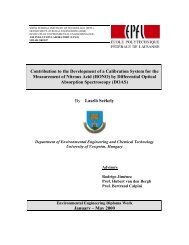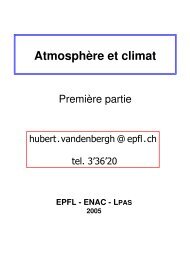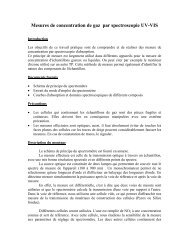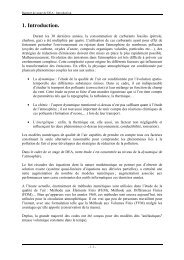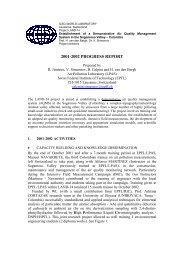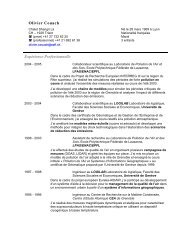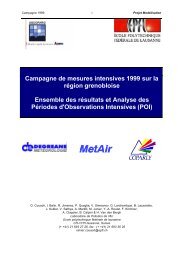Diploma report Implementation and verification of a simple ... - LPAS
Diploma report Implementation and verification of a simple ... - LPAS
Diploma report Implementation and verification of a simple ... - LPAS
You also want an ePaper? Increase the reach of your titles
YUMPU automatically turns print PDFs into web optimized ePapers that Google loves.
In order to compute hydrostatic balance we need to express θ <strong>and</strong> π as functions <strong>of</strong> z<br />
only. θ(z) can be obtained by integrating equation (57) in z :<br />
( N<br />
2 )<br />
θ(z) = θ s exp<br />
g z . (58)<br />
where θ s = θ(0). Substituting (54) in (53) <strong>and</strong> then writing this in terms <strong>of</strong> π <strong>and</strong> θ yields<br />
Integrating in z gives the equation for π<br />
π(z) = 1 −<br />
∂π<br />
∂z = − g<br />
C p θ . (59)<br />
g2<br />
(1 − exp(−N2 z)), (60)<br />
C p θ s N 2 g<br />
<strong>and</strong> this equation is used to compute hydrostatic stratification. Then performing a backsubstitution<br />
T = πθ,<br />
p = p s π Cp/R d,<br />
ρ =<br />
R p<br />
d T ,<br />
(61)<br />
ρe =<br />
γ − p<br />
1 ,<br />
yields the values for the components <strong>of</strong> q.<br />
3.7 Boundary conditions<br />
In an atmospheric limited area model, only the lower boundary is physical. The other sides<br />
<strong>of</strong> the spatial domain are unbounded, meaning that the fluid flows in an exterior domain,<br />
<strong>and</strong> artificial boundaries must be introduced. In order to deal with the boundaries <strong>of</strong> the<br />
computational domain boundary conditions must be specified, for both artificial <strong>and</strong> physical<br />
boundaries.<br />
F n<br />
In the methods studied here, the value Q n ij<br />
is updated by computing the fluxes F<br />
n<br />
i−1/2,j ,<br />
i+1/2,j , Gn i,j−1/2 <strong>and</strong> Gn i,j+1/2 . For doing that the neighboring cell values Qn i−1j , Qn i+1j , Qn ij−1<br />
<strong>and</strong> Q n ij+1 are needed. But for the cells at the edges <strong>of</strong> the computational domain one or<br />
more <strong>of</strong> these values are missing. The general approach to this problem is to extend the<br />
computational domain to include a few additional cells, called ghost cells, on each side.<br />
Figure 3 shows a portion <strong>of</strong> a grid on the computational domain that consists <strong>of</strong> interior<br />
cells labelled by i = 1, 2, ..., N x <strong>and</strong> j = 1, 2, ..., N z <strong>and</strong> that is extended by introducing<br />
two ghost cells on each side, for i = −1, 0 <strong>and</strong> i = N x + 1, N x + 2 <strong>and</strong> for j = −1, 0 <strong>and</strong><br />
j = N z + 1, N z + 2. The values in the ghost cells are set at the beginning <strong>of</strong> each time step<br />
based on data in the interior cells in a manner that depends on the boundary conditions.<br />
This provides the neighboring cell values needed in updating the cells near the boundary <strong>of</strong><br />
the domain.<br />
The number <strong>of</strong> ghost cells depends on the stencil <strong>of</strong> the method. For a three-point method,<br />
only one ghost cell on each side is needed to compute the fluxes, while two are required with<br />
a five-point stencil.<br />
18



